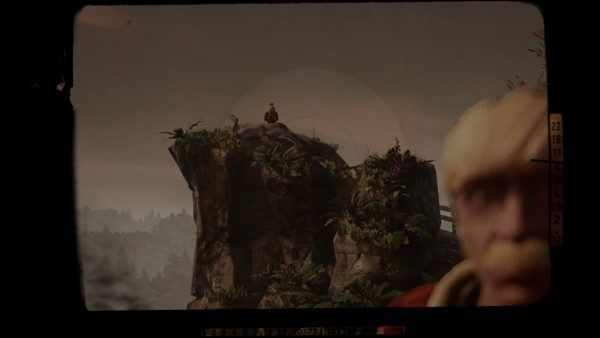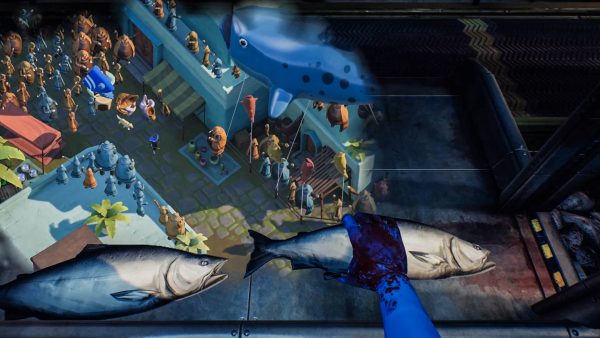
Opened World: Fictions Within Fictions
Miguel Penabella thinks videogames are better with stories.
Regrettably, it seems that every new videogame that lacks complex gameplay mechanics or focuses on storytelling becomes a critical battleground. Apparently it’s not enough for Proteus to be a game about walking around an island or Gone Home a game about interacting with objects to piece together a mystery. These descriptions grossly oversimplify the work that these games accomplish, but such generalizations are what many games critics and scholars have been making. The new storm stirred up by Ian Bogost and his breathtakingly useless argument against storytelling in games for The Atlantic appoints Giant Sparrow’s What Remains of Edith Finch as the latest object of inquiry. Here, Bogost calls to deemphasize storytelling in games, arguing that the medium-specific tools at videogames’ disposal are ill-equipped to handle narratives that would be better served by mediums like film, television, and literature. The tired argument is laughably melodramatic: whenever a game tries to tell a serious story in an unconventional way, critics fall in existential shambles and question the purpose of the entire medium.
What videogame critics like Bogost have done is put games on a pedestal, holding the medium’s narrative aspirations to an impossible standard. Bogost briefly entertains the dream of a mutable storyline that can change in real time as the player makes different choices along the way, branching off into infinite endings like a Borgesian garden of forking paths. Of course, this kind of game where every little player choice has a tangible consequence is a fantasy. Critics and players who buy into such a fantasy set themselves up for inevitable disappointment. “My choices don’t matter!” is the common response, assuming that videogames owe players some form of tangible narrative compensation and reducing storytelling to a simple transaction. Likewise, by comparing videogames to film, television, and literature, critics like Bogost also place those mediums on a pedestal. Bogost assumes that older media have proven their narrative worth, and that they are synonymous with some abstracted sense of artistic prestige. Make no mistake: for every Transparent, there’s an Iron Fist. For every Moonlight, there’s a Fifty Shades Darker.
The reason why film, television, and literature can tell good stories like The Handmaid’s Tale or Toni Erdmann is because good writing manages to emerge seemingly uncompromised. Videogame stories often fall short not because the particulars of the medium limit storytelling, but because good writing in games is frequently erased by the totalizing demands of corporate interests and market expectations that hinder artistic expression. Varied reasons including the iterative nature of game development results in “grey boxes and compromises” between “something new and exciting” versus the demands of “time and budget,” and good writing often fails to make it into the final product. The industry can crush individual expression and creativity, and a unified script is typically one of the first causalities in the corporate machine as rewrites and compromises erode quality storytelling. As a result, we need to champion those efforts when the work of quality writers do emerge rather than give up and move on entirely, as Bogost suggests. His proposal that narrative ambitions may be “a problem to be ignored rather than solved” devalues individuals who toil hard in the industry and regrettably have their work undercut within an oppressive system.
And here, we come to What Remains of Edith Finch, a game that never anticipated being thrust into a conversation about what should constitute a videogame. Despite Bogost’s criticism of videogame stories, the game still projects an obvious love for storytelling with its multilayered fictions embedded within fictions. Like Gone Home, the game involves a return to a somber, vacant house as the player-character probes the lives of the family members who lived there. The eponymous protagonist Edith revisits her childhood home—a skyscraping blend of a treehouse, the Tower of Babel, and the Weasley family’s Burrow—to dig into a multigenerational familial history that unfolds like a magical realist fable. Upon entering the house, Edith discovers a disheveled scene of discarded Chinese takeout boxes, books overflowing from shelves, and photographs vying for wallspace. The setting’s solitude carries a Gothic vibe as though a ghostly presence lingers, involving multiple locked rooms, a mysterious key, secret passageways, and even copies of Wuthering Heights strewn around the home. What Remains of Edith Finch is part of what I would call “Cascadian Gothic,” following other similar Gothic-esque tales set in the Pacific Northwest that involve stories of decaying families, failing careers, native folklore, and ghostly rooms that fit neatly with similar works like the aforementioned Gone Home, The Novelist, and even bits of Life is Strange.

The game centers on death. Edith’s immediate and distant family members have all since died, and a pattern quickly emerges upon exploring the house: each Finch has been cursed with a tragic, early demise. Edith’s mother Dawn subsequently sealed off the rooms of the deceased and displayed a placard with the dates of birth and death—Calvin, 1950-1961 or Barbara, 1944-1960—like a series of mausoleums. Bringing up the pause menu pulls up the full family tree, revealing that the curse has been at work for at least a century. Since Edith is all who remains, she traces the family lives and stories by interacting with their leftover memorabilia. Secret doorways and passages lead into the locked rooms, allowing Edith to gaze into the past and seek the stories she’s looking for. The house serves as a place of memory like a graveyard or a museum, with rooms perfectly frozen in time. The entire game is itself a memory, since Edith is reading from her journal and recounting this experience traversing the house and uncovering the stories of her ancestors in flashback. Thus What Remains of Edith Finch often spills into the realm of dreamlike, unreliable narration; what we’re seeing is filtered through the haze of memory and nostalgia for a lost past.
By guiding players through Edith’s ancestry, the game travels through time. Each sealed room captures the atmosphere of a different time period throughout the past century, and interacting with a memento from the deceased triggers a deeper flashback. Opening up her ancestor Molly’s girlhood diary suddenly transports the player to her point-of-view back in 1947. The setting is still the Finch household, but the space and time period have radically changed in this flashback within a flashback as Molly narrates her story. Her words are inscribed in space; sentences from her diary entries float in the air, suggesting how we remember physical moments via written language. The sequence has a storybook quality as Molly sneaks off at night to find snacks like a grim version of The Very Hungry Caterpillar. She leaps out a window and transforms into various animals including a cat, owl, shark, and sea monster throughout the course of the night, stalking prey around the neighboring woods. Molly’s story openly presents us with the lively imagination of a mischievous child, in which the lines between real and unreal fade with time. Edith mentions that her mom resisted “bringing up the past,” but the abundance of leftover stories to be found around the house suggests that such stories need to come through regardless. Even Molly’s diary reflects an eagerness to pass down stories, doubled again by Edith’s act of recording this family history in her own journal.
In this way, What Remains of Edith Finch is precisely about the desire to tell stories in any way possible. Family histories are recorded and preserved via diverse mediums including diary entries, photography, letters, poetry, and even comic books. By structuring the game as an exploration of objects that trigger micro-narratives embedded within the household environment, its central gameplay rewards player curiosity and thirst for narrative context. When Bogost raises the question, “Are they really stories, when they are really environments?” he underestimates spatial design as yet another effective storytelling device. Although environmental storytelling is correctly identified in his article, critical skepticism towards this technique is odd. Narrative can be embedded in the mise-en-scène of the game, the very spatial design of a scene. As the player unfolds Edith Finch’s story, the space literally opens up as secret passageways, crawlspaces, and hidden doors make themselves known. Narrative cues embedded in spatial design have been used across mediums as diverse as film, theater, and now games, and Bogost’s apprehension insinuates a kind of gatekeeping that devalues the strong interconnectedness games have with other cultural forms.
Environmental cues such as posters tacked up on a wall or a walking crutch overlooking a window refer to specific moments that comprise a larger oral history of the Finch family. The story of Edith’s late father Sanjay is almost entirely told via environmental storytelling, including the newspaper headline, “Relief efforts end in disaster,” clueing the player into another mournful tale. Spatial fixtures such as an Indian flag in her brother Lewis’s room serve as markers for character development, reinforcing his diasporic fondness for a faraway ancestry. Likewise, a strict daily schedule penned on the wall of militaristic grandfather Sam suggests that he probably worked his kids too hard, losing sight of his childhood sense of adventure with age. In lieu of the living characters present onscreen, the environment itself speaks in their absence. The game’s stories are entire human lives and histories: what may seem mundane is really a source of endless narrative potential.

The game does sometimes fall into saccharine territory, yet Giant Sparrow undercuts this with moments of weird playfulness. Barbara’s story unravels as a comic book, complete with framed panels and cel-shaded animation as the space of the house is suddenly reimagined with this new aesthetic. A Tales from the Crypt-esque radio voiceover narrates this comic book within the game’s overarching flashback structure, creating a strange fictionalization within Edith’s memory. Despite this strange narrative layering, the game maintains a playful tone with the inclusion of John Carpenter’s Halloween theme. This bizarre humor undergirds what’s essentially one of many bittersweet, sad stories of loss. Though the game often disguises these individual family member’s accounts with magical realist flourishes and surreal imagery, at the core remains the unexceptional reality of death.
These stories work well because the game plays upon the wistfulness of a hazy memory. Faces of characters are never clearly seen, suggesting a difficulty with coming face-to-face with a difficult past. The exceptional camping trip episode between Sam and a young Dawn literally involves attempts to focus on an indistinct memory. Players are tasked with focusing a vintage camera and snapping photos of each other through a viewfinder, evoking the homespun candidness of home movies. Despite the inevitable confrontation with death that concludes each memory, these snapshots have been preserved for future generations. These photos, along with the many other knickknacks and journals to be found in the game suggest that in spite of death, passing down stories is a necessary human act.
By the same token, a tangible harmfulness can emerge as stories get hazier when they’re recalled from memory or are abstracted as stories within stories within stories. The aforementioned character Lewis loses himself in a fiction of his own making as players operate his mindless day-to-day routine at a fishing cannery while his fanciful imagination produces a simultaneous fantasy of kingdoms and adventure. While completing his job’s menial tasks, players navigate an isometric fantasy game overlaid atop reality, reflecting the character’s fractured mentality dangerously straying further and further away from reality. Thus, What Remains of Edith Finch cautions players against the potential dangers of stories when they become myth and take over one’s life. Stories may be killing these characters; the supposed family curse may simply be a myth passed down and fatalistically willed to reality.
Despite these dangers, the desire to preserve and transmit a familial narrative remains. Edith knows that she too will likely die early, but her journal that details her homecoming and exploration of her ancestor’s histories is similarly written for future generations to come. These are stories she won’t even get to tell. Like her predecessors, she must also recount her life in whatever form she sees fit, whether that be a diary, a photograph, or a poem. Regardless of the formal constraints or the vast differences in time period, each member of the Finch family shares a love for storytelling and its importance can be recognized across generations. It’s the only way to live.
Miguel Penabella is a freelancer and comparative literature academic who worships at the temple of cinema but occasionally bears libations to videogames. His written offerings can be found on PopMatters, First Person Scholar, and Unwinnable, and he blogs on Invalid Memory.